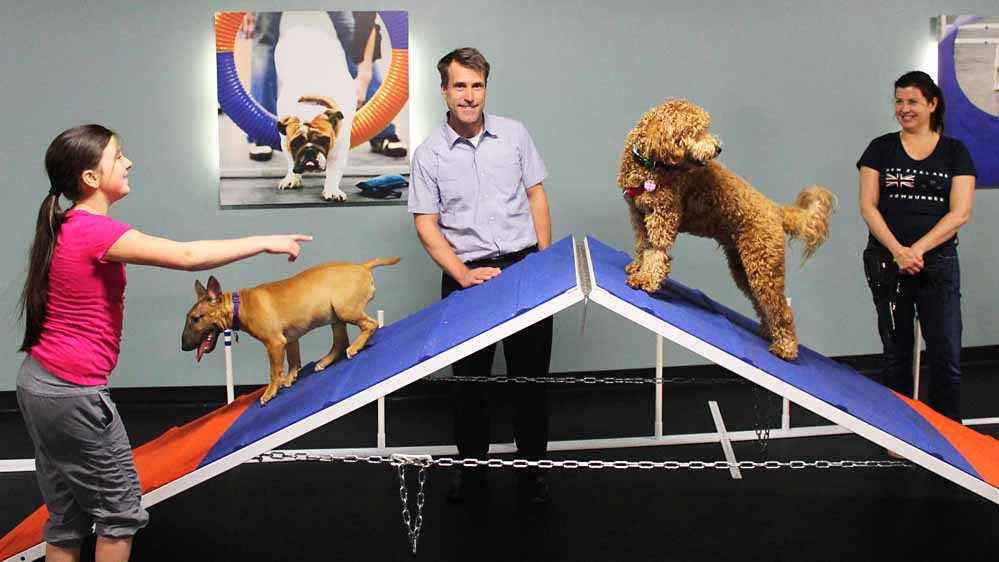How Dog Training Near Me Helps Build a Strong Bond with Your Dog
Wiki Article
A Novice's Journey Into the World of Pet Training: Trick Insights and Approaches
A novice's journey right into pet dog training often discloses a complicated interplay of understanding canine behavior and reliable communication strategies. New fitness instructors swiftly discover the value of positive reinforcement and the demand for consistency in their strategy. As they navigate via vital commands and socialization, obstacles may emerge. These experiences can check their patience, yet they additionally existing chances for development. What insights will become they face common barriers and build a more powerful bond with their dogs?Recognizing Your Canine's Actions
How can a pet dog's behavior expose its psychological state? Recognizing canine habits is important for effective training and constructing a solid bond. Pets connect with body language, articulations, and activities, each offering understanding into their feelings. As an example, a wagging tail usually suggests happiness, while a lowered tail might indicate anxiety or submission.Similarly, a pet dog that barks exceedingly could be expressing stress and anxiety or enjoyment, while an unwinded pose recommends convenience and satisfaction. Observing these habits aids owners respond appropriately, fostering a helpful atmosphere. Furthermore, habits such as pacing or extreme licking can suggest stress and anxiety or pain, signifying a demand for treatment.
Identifying these psychological signs permits animal owners to tailor their training techniques, making sure that they resolve their pet's specific requirements. By recognizing their emotions, owners can nurture a trusting relationship, inevitably leading to even more successful training outcomes.
Necessary Training Tools and Equipment
A variety of essential training devices and tools can substantially enhance the pet training experience. Beginners frequently discover that a well-fitted collar or harness is important for ensuring both comfort and control throughout training sessions. Leashes, preferably 4 to 6 feet long, give the necessary guidance while enabling for freedom of activity. Clickers function as effective devices for noting desired actions, assisting in clearer interaction between the pet dog and the trainer.Additionally, deal with pouches can streamline the procedure of fulfilling etiquette, keeping deals with easily accessible. Training floor coverings or designated rooms aid develop boundaries, urging focus throughout lessons. Toys that advertise interaction, like yank playthings or fetch rounds, can also be used to reinforce training goals. Overall, picking the ideal devices not just aids in efficient training yet also fosters a positive atmosphere, making the training journey pleasurable for both the canine and the fitness instructor.
Favorable Reinforcement Strategies
Positive support techniques are extensively recognized as reliable approaches for motivating preferred behaviors in pets. These methods involve awarding a pet dog for certain actions, reinforcing the likelihood of those activities being repeated. Typical incentives consist of deals with, praise, or play, every one of which offer to motivate the canine favorably. Timing is essential; incentives need to be given quickly after the wanted behavior to create a solid organization.Uniformity is likewise necessary; utilizing the exact same hints and rewards helps the pet comprehend what is expected. In addition, varying the rewards can preserve a dog's interest and enthusiasm during training sessions. Positive support not just boosts obedience yet additionally promotes a relying on bond between the canine and the fitness instructor. This technique contrasts greatly with punitive approaches, promoting an extra satisfying and effective training experience. Generally, favorable reinforcement functions as a foundational component in efficient pet dog training methods.
Fundamental Commands Every Canine Should Know
Basic commands develop the backbone of reliable communication between a dog and its proprietor. Grasping fundamental commands such as "sit," "remain," "come," "down," and "leave it" is essential for establishing a well-behaved pet (Dog Training Near Me). These commands not just ensure safety however also foster manners in different circumstancesThe command "sit" works as a fundamental foundation, advertising patience and emphasis. "Stay" enhances self-constraint, enabling dogs to continue to be stationary up until given more directions. "Come" is important for recall, making certain canines return without delay when called. The "down" command assists in relaxing an excited pet dog, while "leave it" teaches them to neglect diversions, enhancing their security in day-to-day environments.
Educating these commands via positive support, such as treats and praise, motivates pets to learn and react voluntarily. Constant method and patience are basic, leading the way for a harmonious connection between the canine and its proprietor.
Socialization: The Key to a Well-Adjusted Pet
Socialization is vital for developing a well-adjusted pet dog, as it highlights the significance of early direct exposure to various settings and experiences. Using favorable communication methods can substantially boost a pet dog's capability to thrive and adjust in different social setups. Acknowledging the indications of effective socialization is vital for owners to analyze their dog's progression and general well-being.Value of Early Direct Exposure
They are much more most likely to establish right into well-adjusted grown-up canines when pups are exposed to a selection of individuals, environments, and experiences during their formative months. Very early direct exposure is important as it assists young puppies discover to navigate various scenarios, lowering anxiety and anxiousness in novel situations. Socialization fosters self-confidence, enabling canines to communicate positively with various other pets and people. The absence of such experiences can bring about behavior concerns, such as hostility or excessive shyness. By presenting pups to numerous stimuli-- like sounds, settings, and social experiences-- owners can considerably influence their future temperament and flexibility. As a result, focusing on early exposure plays a vital role fit a canine's behavior, guaranteeing they turn into balanced and friendly buddies.Positive Communication Techniques
A selection of positive communication techniques can significantly boost a pet dog's socializing process, resulting in a well-adjusted buddy. Taking part in regular, positive support approaches helps pet dogs associate new experiences with fulfilling outcomes. Methods such as clicker training, treats, and verbal appreciation urge desired habits and advertise self-confidence. Structured playdates with various other dogs offer necessary social abilities, while exposure to diverse atmospheres, appears, and individuals fosters versatility. Owners must additionally exercise patience and remain calm, as a kicked back disposition can assist ease a pet's anxiety during socialization. Routine training sessions that integrate fun and satisfying tasks reinforce the bond in between the dog and the owner, creating a foundation for a relying on partnership. These communications are critical for developing an all-around canine companion.Signs of Successful Socialization
How can one identify a well-socialized pet dog? A well-socialized canine shows peace and self-confidence in numerous settings and around various people and animals. It responds positively to new experiences, showing curiosity instead of fear. When fulfilling other dogs, a well-socialized dog involves in play or continues to be kicked back, preventing hostility or excessive anxiousness. Additionally, such a canine demonstrates manners, reacting to commands and hints in diverse scenarios. Indications of successful socializing additionally include adaptability; the pet can change its behavior whether in the house, in public areas, or during traveling. Generally, a well-socialized canine personifies sociability, balance, and comfort, mirroring the financial investment in correct training and direct exposure during its developing stages.Usual Training Difficulties and Solutions

Leash Pulling Solutions
Lots of animal owners encounter the obstacle of chain pulling, a common actions that can make strolls discouraging and unmanageable. To address this concern, instructors commonly recommend numerous efficient strategies. Using a front-clip harness can lower pulling by rerouting the pet dog's attention. Second, showing the "heel" command motivates the dog to stroll calmly next to the owner. When the pet stays at the proprietor's side can strengthen this habits, consistent reinforcement with deals with or applaud. In addition, stopping and standing still whenever the pet pulls can show them that progressing just occurs when they are walking nicely. Via persistence and uniformity, pet owners can change walks right into pleasurable experiences for both themselves and their pets.Excessive Barking Administration
Too much barking can become a considerable difficulty for pet dog owners, commonly leading to irritation and stretched connections with neighbors. Recognizing the underlying factors for barking is essential; canines may bark out of dullness, anxiousness, or a demand for focus. To resolve this problem, owners should first recognize triggers and supply psychological stimulation through interactive playthings and routine exercise. Consistent training commands, such as "peaceful," can help reinforce preferred habits. Positive reinforcement, consisting of treats and appreciation, try this website can encourage dogs to remain calm. Additionally, creating a structured atmosphere with marked silent times can be beneficial. In more severe cases, seeking advice from a specialist pet dog fitness instructor or behaviorist may be required to create a customized approach to managing extreme barking efficiently.Jumping Behavior Correction
While it might appear charming when a pet dog jumps up to greet individuals, this habits can rapidly become bothersome, particularly when it is unwelcome or too much. Lots of canine proprietors run into difficulties with jumping, often resulting in scratched garments or shocked guests. To fix this behavior, regular training is imperative. One effective approach includes instructing the dog an alternate behavior, such as resting when greeting a person. Reinforcement, through treats or appreciation, encourages the desired activity. Additionally, proprietors should prevent providing attention when the pet jumps; rather, they should await calm habits prior to engaging. Patience and uniformity are important, as leaping behavior may take time to reduce, but with appropriate techniques, it can be efficiently handled.The Relevance of Consistency and Persistence
Uniformity and patience are foundational merits in the domain name of dog training. Successful training counts on the consistent application of strategies and commands, guaranteeing that the pet dog recognizes expectations. Inconsistent cues can result in complication, preventing the learning process. If an instructor permits an actions one day and dissuades it the next, the pet might end up being visit site unsure of what is acceptable.Persistence complements uniformity, as discovering takes time. Dogs do not understand commands or habits immediately; repetition and support are important. A trainer should remain committed and tranquil, identifying that problems become part of the journey. Disappointment can cause unfavorable interactions, impeding progress.
Via regular support and the readiness to be individual, fitness instructors promote a trusting relationship with their pets. This bond not just aids in communication yet additionally boosts the general training experience, resulting in a well-behaved companion.
Frequently Asked Inquiries
How Lengthy Does It Normally Take to Train a Pet?
The duration for educating a canine differs significantly, typically varying from weeks to several months. Factors affecting this timeline include the pet dog's age, type, prior experiences, and the uniformity of the training methods utilized.Can I Train an Older Dog Successfully?
Educating an older pet is certainly reliable, though it may need patience and consistency. Older pets can learn new commands and actions; however, their previous experiences and habits must be considered during the training procedure.What Are Some Signs My Canine Is Worried Throughout Training?

Should I Make Use Of Clicker Educating for All Pet dogs?
The performance of remote control training differs among pets. Some respond well as a result of positive support, while others may not involve. Observing each dog's habits and choices is crucial for figuring out the very best training technique.How Do I Manage Distractions Throughout Educating Sessions?
Handling diversions during training sessions needs perseverance and consistency. Slowly present distractions, benefit emphasis, and keep sessions short. Producing a regulated setting assists pet dogs learn to concentrate, enhancing their capacity to comply with commands in the middle of diversions.A novice's journey into dog training often reveals an intricate interplay of understanding canine actions and effective communication strategies. A variety of essential training tools and equipment can noticeably enhance the canine training experience. Furthermore, differing the incentives can keep a pet's interest and enthusiasm during training sessions. When meeting various other dogs, a well-socialized pet dog involves in play or continues to be loosened up, staying clear of aggression or excessive anxiety. Signs of a stressed canine during training consist of extreme panting, drooling, a tucked tail, great site avoidance behaviors, or a lack of emphasis.
Report this wiki page